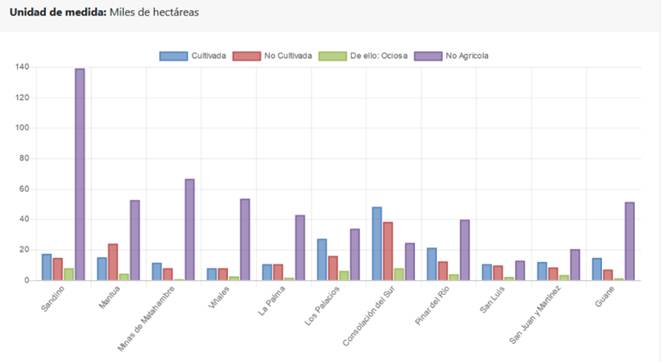Meu SciELO
Serviços Personalizados
Artigo
Indicadores
-
 Citado por SciELO
Citado por SciELO
Links relacionados
-
 Similares em
SciELO
Similares em
SciELO
Compartilhar
Cooperativismo y Desarrollo
versão On-line ISSN 2310-340X
Coodes vol.10 no.1 Pinar del Río jan.-abr. 2022 Epub 30-Abr-2022
Original article
System for the visualization of food production indicators through the SAEN+C Pinar Observatory
1 Universidad de Pinar del Río "Hermanos Saíz Montes de Oca". Editorial Universitaria. Grupo de investigación en Gestión de Información, Conocimiento y Tecnologías (proGINTEC). Pinar del Río, Cuba.
The country has different national programs that procure food. However, it is not possible to guarantee sufficient diversity in the food diet. The monthly subsidized food basket covers almost forty percent of the recommended energy intake, the rest is covered by households in non-subsidized markets characterized by irregular supply. This situation, in part, is generated by low productivity in the agro-industrial sector, low agricultural yields and high post-harvest losses, just to mention a few causes. Faced with this scenario, the country approved a plan to support, from science, food production as a way to achieve greater food sovereignty in the nation. This research aims to show the development of a system that allows the visualization of indicators related to food production in the territories, from the Observatory of Food Sovereignty and Nutritional Education of Pinar del Río. Theoretical and empirical methods were used, which allowed achieving a scientific, technological and practical result, considered relevant for the sector because it integrates in its various services analysis with indicators of different structure and analytical categories, measurement sources and technologies that facilitate the mapping of the baseline that each territory needs for its projection, planning and control of results. This system, in addition to working the baseline, is flexible and allows the introduction of new categories, analysis methodologies and indicators, which increase its prospective use value.
Key words: observatory; indicators; information management; information analysis; food sovereignty; local food systems; Pinar del Río
Introduction
The recent review conducted by the World Food Program (PMA in Spanish) to the country on progress towards the achievement of the 2030 Agenda demonstrated in the common assessment that the six strategic axes of the National Economic and Social Development Plan until 2030 are in line with the 17 Sustainable Development Goals of the 2030 Agenda (PMA, 2020); and, the country's strategic plan is also in line with the United Nations Sustainable Development Cooperation Framework (2020-2024).
The WFP will support the Municipal Self-Supply Program, which contributes to reducing the volume of food imports, and school feeding programs, maternal and child health care, and care for the elderly. Also, and mainly, the Tarea Vida, which is the State Plan to Combat Climate Change, and the Food Sovereignty and Nutritional Education Plan (SAEN Plan in Spanish). The latter is the subject of interest in this research.
The SAEN plan insists on improving the work management of the Cuban State in the organization of local, sovereign and sustainable food systems that integrate the production, transformation, commercialization and consumption of food. It also seeks to promote a food culture and nutritional education for a healthy population. In this sense, this research recognizes that, although guaranteeing food security is a State responsibility, research from multiple areas of knowledge is required, as well as coordinated efforts of different sectors and actors of society in the different dimensions of food security in order to guarantee it in a sustainable and sustained way (Díaz Pérez et al., 2021).
The construction of observatories is one of the orientations of the President of the Republic, which allow contributing to the search for solutions that stimulate food production from the surveillance of the main sectors involved, the follow-up of product lines and assortments, as well as the monitoring of their critical factors. This orientation supports, from diverse and different perspectives, the production of food with more science.
The construction of observatories also responds to one of the four central objectives of the SAEN Plan at the national level: the lack of a food security monitoring system, which is also related to the necessary mobilization of communication to strengthen food and nutritional security in the country (PMA, 2020). These issues are included in strategic effect axis four, which will work to ensure that by 2024 Cuba's national and local authorities have greater capacities to manage the country's inclusive, comprehensive and adaptable food and nutrition systems (PMA, 2020).
On this last point, since the inclusion of the concept of Green Productivity (GP), which values both economic development and environmental protection as fundamental strategic elements for sustainable development, the need to measure the sustainable productivity of agricultural production systems has become more explicit.
Some of the most notable examples of measurement at the international level, according to Laborde and Piñeiro (2018), are the following:
Organization for Economic Cooperation and Development agro-environmental indicators database, which contains data on soil, water, biodiversity and by-products of material input use (fertilizers, pesticides and energy)
Food and Agriculture Organization of the United Nations agro-environmental indicators database on greenhouse gases, soil carbon content and agricultural water withdrawals
United Nations System of Environmental and Economic Accounting (SEEA), which includes natural flows of products (water, energy, emissions and waste) and stocks and changes in environmental assets (timber, water, fisheries, soil and land)
World Klems Initiative (2010), created to promote and facilitate the analysis of productivity at the global level, which needs to be strengthened to incorporate sufficient and disaggregated information on the agricultural sector and include land as a factor of production
However, despite these and other methodologies and systems that exist at the international and regional levels, sustainable improvements in agricultural productivity cannot be efficiently monitored, nor they can be used to double agricultural productivity and ensure sustainable food production through the efficient and sustainable consumption and use of natural resources.
Cuba is not exempt from these monitoring and measurement difficulties. The country needs an agricultural monitoring system that periodically supervises the programmed actions, as planned, with efficiency criteria established for the actual delivery of results, inputs and time compliance, as a way to know and determine whether or not the products actually achieved comply with what was planned in the plan in terms of time, input costs and other resources, including sustainability variables in the analysis.
But not only that, it is necessary, based on more specific measurements, to systematically determine the relevance, efficacy, efficiency and impact of agricultural activities and their results; only then it will be possible to make better documented decisions based on the quality of the data, which will help to foresee and anticipate scenarios in agricultural environments that do not threaten the nation's food sovereignty and security.
In order to fairly achieve the above, this research shares the criterion that public policies, regulations and procedures are first needed, together with strategies that establish a framework for monitoring and measurement that encompasses the three areas of sustainability, i.e., indicators that are not only economic, but also environmental and social. The quality of the measurements and the real possibilities of forecasting and modeling future agricultural scenarios through their use will depend, to a large extent, on their systemic integration.
The national reality is still quite far from this pipe dream. However, the country has a wide range of measurement systems that support this activity at the national level, according to a recent report by the National Bureau of Statistics and Information (Onei, 2020); for example, the publication "Agricultural Sector. Selected Indicators", which aims to provide information on the behavior of the main indicators of non-cane agriculture and livestock.
Other sources of information used are: data obtained from the National Statistical Information System, through forms 0336-07 and 0436-07 "Agricultural Sector. Selected Indicators"; those from the Ministry of Agriculture: bulletins from the Union of Enterprises of the National Poultry Complex, the Swine Production Group, the National Livestock Control Center; as well as information from the Directorate of Urban and Suburban Agriculture of the Institute for Fundamental Research in Tropical Agriculture. These are the main measurement systems that exist in the country with standardized and reliable information in their use.
Correspondingly, several national researchers, together with the country's top management, formed a working system for the Food Sovereignty and Nutritional Education plan that has among its objectives: "to create the Technological Observatory on the management of Local Food Systems and its connection with other info technological platforms at different scales, as a priority with the government network and the Ministry of Agriculture" (Díaz-Canel Bermúdez et al., 2020).
Based on these orientations, and in correspondence with the international state of the art, the construction of the different stages of the Food Sovereignty and Nutrition Education Observatory of Pinar del Río (SAEN+C Pinar in Spanish) began in the province of Pinar del Río (Díaz Pérez et al., 2021).
The fourth stage of the SAEN+C Pinar Observatory deals with the subject of study of this research, in this case, articulating different data from different official sources of the territory to establish a follow-up, monitoring and evaluation of the behavior of certain productions that are part of the Food Sovereignty Plan.
The objective of this research is to show the development of a data management system that calculates and visualizes different indicators related to food production, enhancing the follow-up, monitoring and evaluation that supports decision making in the sector.
Materials and methods
The research was carried out on the philosophical and methodological basis of Dialectical and Historical Materialism. Among the theoretical level methods, the following were used: the historical-logical, to work retrospectively on the information recovery of the whole domain of statistical data in Pinar del Río, as well as its analysis and evolution through time; modeling was applied for the conceptual, graphic and functional design of the informational architecture and software engineering of the computer system, as well as for the algebraic modeling of the different indicators; and the systemic-structural, for the harmonic articulation from a holistic vision of all the data structures, official information sources, systems and technologies, metric analysis and statistical modules, with the different value-added products and services offered by the SAEN+C Pinar Observatory.
The empirical methods used were: measurement, for the use of certain metric and statistical indicators, and direct observation, which yielded circumstantial elements that enriched proposals for new analyses, functionalities and valuable services.
The methodology used in this study combines different techniques and procedures developed by the Research Group on Information, Knowledge and Technology Management (proGINTEC in Spanish) of the University of Pinar del Río "Hermanos Saíz Montes de Oca" (Díaz Pérez, 2017, 2018, 2021; Giráldez Reyes et al., 2008, 2020), with methods from the information sciences for the measurement and representation of different units of analysis (Díaz Pérez & Giráldez Reyes, 2020).
Results and discussion
The observatory that supports the Food Sovereignty and Nutritional Education Program for the Production of Food with more Science in Pinar del Río is called SAEN+C Pinar.
The premise of this observatory, in the defense of food sovereignty, is the need for greater access to reliable, standardized and structured data that facilitate research in different areas of knowledge, based on the contrasting and verifiable data principles. As defined by Díaz Pérez (2020), it is necessary to have meaningful information that is, in turn, reliable, relevant, truthful, timely and with an adequate balance between quantity and quality.
Without information and knowledge, innovation is not possible, and without data, it is not possible both information and knowledge management (Díaz Pérez, 2020). This triad is essential, which is why it accompanies each stage of construction of the SAEN+C Pinar Observatory, and is best perceived in the fourth stage. This stage is oriented to the management of indicators that show the behavior of food production in the province from certain spheres.
Stage IV results: indiSAEN
The scientific and technological novelty of the indiSAEN system is that it allows the management, analysis and representation of structured data in different formats, coming from different official sources, disaggregated at different levels and published in various systems.
From its scope, it has the purpose of standardizing different measurement systems that allow establishing homogeneity in the most representative units of analysis of the domain to be analyzed. This stage of the SAEN+C Pinar Observatory is very complex; since it groups together different sets of statistical indicators that express the behavior of multiple spheres that participate in or influence food production in the territory.
Below are several examples that represent the functions of indiSAEN within the SAEN+C Pinar Observatory with its analysis possibilities, differentiated by productive line and sector based on the data processed by the Department of Statistics and Planning of the Territorial Delegation of the Ministry of Agriculture and the National Statistics and Information Office in Pinar del Río.
Figure 1, for example, shows the total sowing in the province in terms of plan and real for the last five years, representing a decrease in hectares.
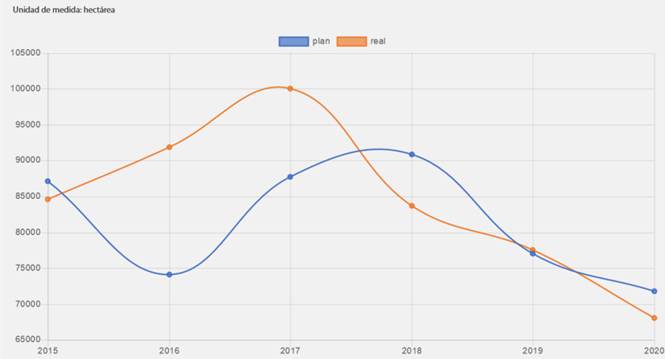 Source: SAEN+C Pinar Observatory
Source: SAEN+C Pinar Observatory Fig. 1 indiSAEN: evolution of plan and real of total sowing of the province
In the sowing parameters, using the indiSAEN system, it is also possible to manage the evolutionary behavior of viands and vegetables, as well as independently some important crops for the province and the country, such as potato, for example (Fig. 2).
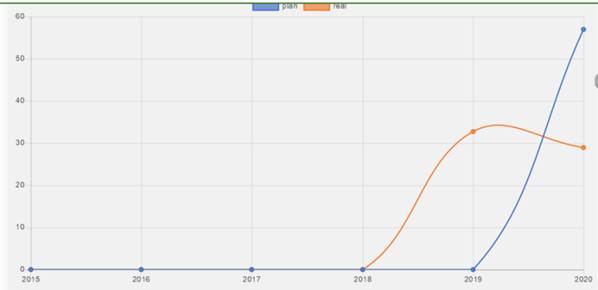 Source: SAEN+C Pinar Observatory
Source: SAEN+C Pinar Observatory Fig. 2 indiSAEN: evolution of potato sowing (plan-real) in the province
Productions are particularly relevant analysis indicators for the SAEN+C Pinar Observatory, which uses the indiSAEN system to monitor production per ton of viands (Fig. 3) and vegetables (Fig. 4), as well as citrus fruits, tubers and roots, among other productions in the province.
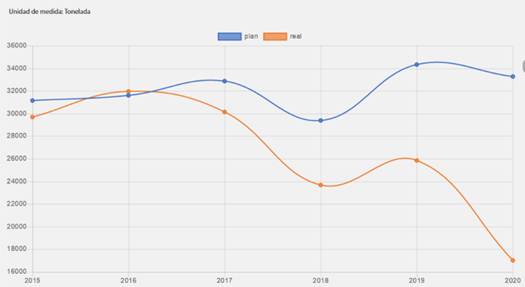 Source: SAEN+C Pinar Observatory
Source: SAEN+C Pinar ObservatoryFig. 3 indiSAEN: evolution of the total banana production (plan-real) of the province
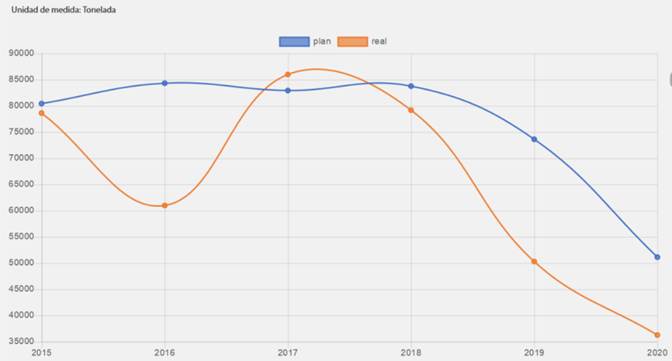 Source: SAEN+C Pinar Observatory
Source: SAEN+C Pinar Observatory Fig. 4 indiSAEN: evolution of tomato production (plan-real) in the province
indiSAEN also allows monitoring pork production by different indicators such as total production, production by enterprises, as well as slaughtering and destinations, separating the national balance from the rest of the destinations. This system also makes it possible to monitor the mass stock of breeders; predictively monitoring total fattening, normal fattening and average fattening weight, among other indicators of use value. For example, in total swine production, the province has had satisfactory results in recent years (Fig. 5).
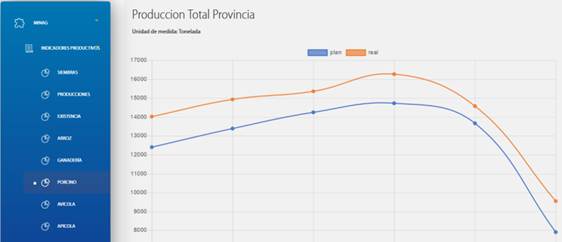 Source: SAEN+C Pinar Observatory
Source: SAEN+C Pinar Observatory Fig. 5 indiSAEN: total swine production (plan-real) in the province from 2015-2020
In poultry production, indiSAEN also provides extensive monitoring of the provincial domain, facilitating through its services analyses by: total poultry meat production, specialized meat production and delivery to the State, as well as monitoring of egg production, the existence of poultry mass, layers, light and heavy breeders, mountain hens, quails, among other production lines (Fig. 6).
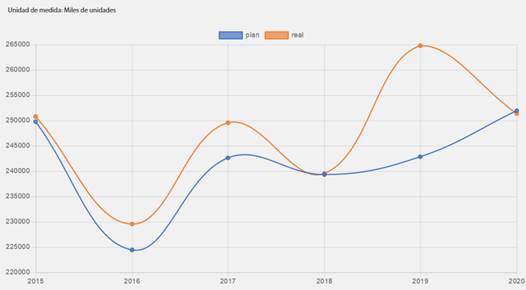 Source: SAEN+C Pinar Observatory
Source: SAEN+C Pinar Observatory Fig. 6 indiSAEN: egg production in thousands of units (plan-real) of the province
The system also monitors the performance of the rice, forestry, beekeeping, livestock and fishing sectors. The latter, through indicators that visualize the existence of beehives, wax production and honey production with different destinations.
The holistic vision of the SAEN+C Pinar Observatory also includes the analysis of indicators related not only to planting and production, but also to the adequate use of the land. It analyzes the genetic classification and agro-productive classification of soils, their distribution and tenure, as well as their forms of use. Figure 7, for example, shows the monitoring of land use by municipality.
Having a system that comprehensively manages the statistics of the province's different prioritized programs is a high value-added product for managers, authorities and the government, who need timely data on the specific development of each line of production and assortment in order to make decisions with greater strategic, operational and functional value.
indiSAEN supports the identification of the baseline of each territory for better planning, monitoring, control and evaluation of agricultural policies, strategies for producing results, sector productivity, as well as for improving supply chains and sources of financing, among many other management possibilities offered by the different value-added analyses offered by this system from the SAEN+C Pinar Observatory.
This research shares the criterion that the interpretation of the indicators cannot be sectorial, divided and isolated, since this would only lead to continue doing things in the same way, and would not generate a change in the way of thinking, acting and doing that would guarantee greater sustainability from its three dimensions.
The qualitative dimension should be integrated into each analysis, so that dead points within the food chain that do not compromise production chains or improve yields and production costs can be identified. Work should also continue on the visualization of indicators that better represent the food chain from the ecological, technological, sociocultural and economic aspects, as well as the creation of other indicators that define food and nutritional sovereignty and their application at the municipal level.
In general, the above shows the potential use of the indiSAEN system to monitor, control and evaluate production according to the planned and actual results. It constitutes a reference to identify the starting indicators that each territory has to work with greater efficiency and effectiveness to guarantee its municipal self-sufficiency, as well as the real possibilities of food production in a sustainable way. The information processed by this system documents, through the quality of official public data, quantitative evidence of multiple productive actions in the province that contribute significantly to better decision making in each territory.
Referencias bibliográficas
Díaz Pérez, M. (2017). Sistemas de gestión de información y conocimiento en empresas cooperativas: Sociedades colaborativas de conocimiento. Cooperativismo y Desarrollo, 5(2), 221-232. http://coodes.upr.edu.cu/index.php/coodes/article/view/178 [ Links ]
Díaz Pérez, M. (2018). Procedimiento para el diseño de Sistemas de Gestión de Información en Cooperativas de Producción. Cooperativismo y Desarrollo, 6(1), 26-40. http://coodes.upr.edu.cu/index.php/coodes/article/view/185 [ Links ]
Díaz Pérez, M. (2020). La Soberanía Alimentaria y Nutricional desde la perspectiva de un Observatorio Territorial. Cooperativismo y Desarrollo, 8(3), 466-477. https://coodes.upr.edu.cu/index.php/coodes/article/view/393 [ Links ]
Díaz Pérez, M. (2021). Invenciones sobre COVID-19 registradas en Estados Unidos. Revista Cubana de Información En Ciencias de la Salud, 32(1), e1815. http://www.acimed.sld.cu/index.php/acimed/article/view/1815 [ Links ]
Díaz Pérez, M. & Giráldez Reyes, R. (2020). Observatorio Métrico de Coronavirus de la Universidad de Pinar del Río, Cuba. Revista Cubana de Información en Ciencias de la Salud, 31(3), e1589. http://www.rcics.sld.cu/index.php/acimed/article/view/1589 [ Links ]
Díaz Pérez, M., Triana Velázquez, Y., Brizuela Chirino, P. R., Rodríguez Font, R. J., Giráldez Reyes, R. & Blanco Borrego, J. (2021). Soberanía Alimentaria y Educación Nutricional desde la ciencia de la sostenibilidad: Observatorio SAEN+C Pinar. Universidad y Sociedad, 13(5), 9-19. https://rus.ucf.edu.cu/index.php/rus/article/view/2206 [ Links ]
Díaz-Canel Bermúdez, M., Núñez Jover, J. & Torres Paez, C. C. (2020). Ciencia e innovación como pilar de la gestión de gobierno: Un camino hacia los sistemas alimentarios locales. Cooperativismo y Desarrollo, 8(3), 367-387. https://coodes.upr.edu.cu/index.php/coodes/article/view/372 [ Links ]
Giráldez Reyes, R., Díaz Pérez, M. & Armas Peñas, D. (2008). PROInTec: Un software para el tratamiento inteligente de datos sobre patentes. ACIMED, 17(5). http://scielo.sld.cu/scielo.php?script=sci_abstract&pid=S1024-94352008000500006&lng=es&nrm=iso&tlng=es [ Links ]
Giráldez Reyes, R., Díaz Pérez, M., Rodríguez Font, R. J., Brizuela Chirino, P. R. & Blanco Borrego, J. (2020). Encadenamiento social de la ciencia mediante el Observatorio Métrico de Coronavirus. Universidad y Sociedad, 12(4), 294-302. https://rus.ucf.edu.cu/index.php/rus/article/view/1647 [ Links ]
Laborde, D. & Piñeiro, V. (2018). Monitoring agricultural productivity for sustainable production and R&D planning. Economics, 12(1). https://doi.org/10.5018/economics-ejournal.ja.2018-66 [ Links ]
Onei (2020). Anuario Estadístico de Pinar del Río 2019. Oficina Nacional de Estadística e Información. http://www.onei.gob.cu/sites/default/files/anuario_est_provincial/21_anuario_estadistico_de_pinar_del_rio_2019.pdf [ Links ]
PMA (2020). Segundo período de sesiones ordinario de la Junta Ejecutiva. Programa Mundial de Alimentos. https://executiveboard.wfp.org/es/meeting/1078 [ Links ]
World KLEMS Consortium (2010). WORLD KLEMS. https://www.worldklems.net/wkhome [ Links ]
Received: April 05, 2022; Accepted: April 22, 2022











 texto em
texto em 

